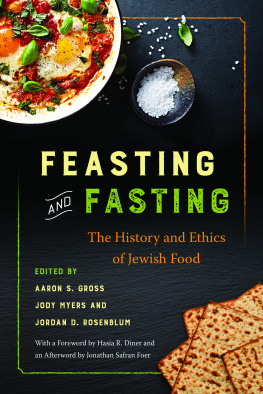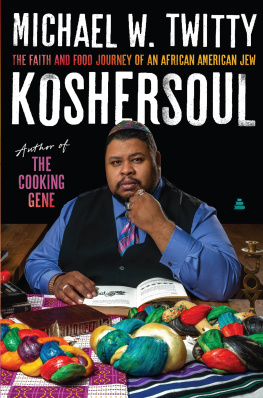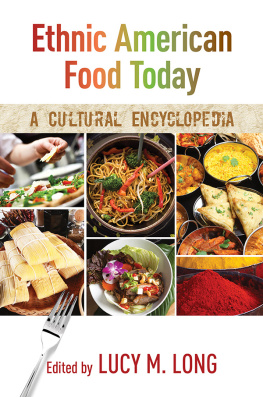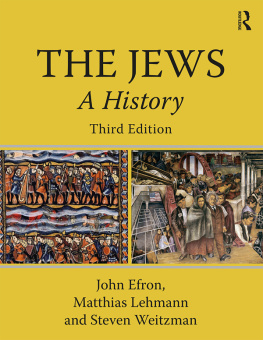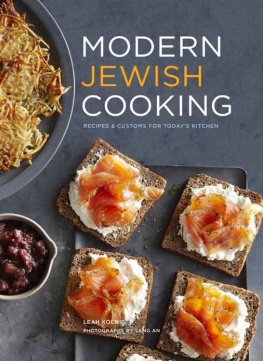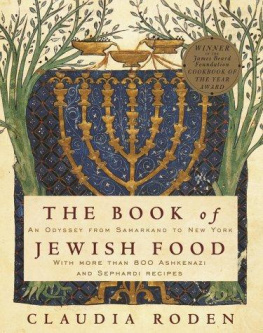Tastes of Faith: Jewish
Eating in the United States
The Jewish Role in American Life
An Annual Review of the Casden Institute for the
Study of the Jewish Role in American Life
Tastes of Faith: Jewish
Eating in the United States
The Jewish Role in American Life
An Annual Review of the Casden Institute for the
Study of the Jewish Role in American Life
Volume 15
Steven J. Ross, Editor
Leah Hochman, Guest Editor
Lisa Ansell, Associate Editor
Published by the Purdue University Press for
the USC Casden Institute for the Study of the
Jewish Role in American Life
2017
University of Southern California
Casden Institute for
the Study of the Jewish Role in American Life.
All rights reserved.
Production Editor, Marilyn Lundberg
Cover photo supplied by Getty Images, www.gettyimages.com/license/634475051.
Courtesy of Westend61.
Breakfast, bagels, vegetables, salmon and ham.
Cloth ISBN: 978-1-55753-799-7
ePDF ISBN: 978-1-61249-524-8
ePUB ISBN: 978-1-61249-525-5
Published by Purdue University Press
West Lafayette, Indiana
www.thepress.purdue.edu
Printed in the United States of America.
For subscription information,
call 1-800-247-6553
Contents
On Eating and Being Jewish: How Taste Has Shaped Identity
Leah Hochman, Guest Editor
The Feast at the End of the Fast:
The Evolution of an American Jewish Ritual
Growing up in an Ashkenazi household parented by two Holocaust survivors, our dinners had a rhythm and routine that defined the week. You knew what day it was by what you ate that night: Thursday was dairy night, though much to the delight of my sister and myself, Mrs. Pauls Fishsticks would often substitute for the blander fare of cheese blintzes. Sundays, as was the norm in Jewish households in Queens, New York, we either brought in delicatessen or Chinese food. Every other night was meata luxury my parents used to celebrate their more prosperous life in postwar American.
The food Jews eat and the powers of the Jewish palate continue to define the American-Jewish experience, simultaneously serving as points of assimilation and self-preservation. Whereas traditional Jewish food used to represent a resistance to assimilationa safe haven to preserve a taste of the old country in a new worldtoday it has come to mark a hybrid of identities in the constant fluidity of the American cultural landscape. There is a certain comfort in the familiarity of a hamishe matzo ball that the modern assimilated American Jew has come to rely on; or eating in a kosher-style deli that represents a safe space in a world that has left traditional Jewish communal existence behind. Even Noahs Bagels, a once kosher establishment, now offers a ham sandwich served on a challah roll. It is as if no matter how far we have deviated from classical Jewish observance, there are still elements of our collective culinary past that we need to survive, if only to remember who we once were before the Holocaust.
This volume explores the role food has played in Jewish life across the centuries: from the humble bagel of the 1500s to the emotionally fraught twenty-first-century meal-time conversations of the fictional Pfefferman family, subjects of the Amazon original series Transparent, where serious boundary issues unravel at the family dining room table. Our authors also explore the Jewish origin of the chocolate trade in the Americas; the culinary travails of traveling Jewish peddlers; the rise of Jewish vegetarianism; the meaning of the feast that follows the Yom Kippur fast; and an assessment of how food is interwoven into the very fabric of Jewish identity.
I wish to acknowledge the excellent work of our guest editor Dr. Leah Hochman, Director of the Louchheim School for Judaic Studies and Associate Professor of Jewish Thought at the Los Angeles campus of Hebrew Union College-Jewish Institute of Religion. Dr. Hochmans compilation of articles offers a broad and rich examination of the impact of food has had on the creation and constant redefinition of Jewish identity in America.
The Casden Institute dedicates this volume to Rob Eshman, author of the Foodaism Blog, who is leaving the Jewish Journal after twenty-three years of service, many of them as publisher and editor-in-chief.
Steven J. Ross
Myron and Marian Casden Director
Professor of History
Editorial Introduction
On Eating and Being Jewish:
How Taste Has Shaped Identity
So goes an old joke about Jews in history: They tried to kill us. We survived. Lets eat. As stoic as it is pithy, the sentiment reveals a long-standing self-understanding of Jewish longevity, persecution and irony. Chief among its truisms is the centrality of food in Jewish life, culture, and religious experience. Every holiday, every life cycle event, virtually every Jewish gathering employs food as a means of marking connections to seasonal bounty, cultural heritage and religious commitment. Apples and honey (or dates and pomegranate) on Rosh Hashanah, matzah on Passover, bagels after the ceremony that welcomes infants into the community, Chinese food on Christmas Evename the occasion and someone can name a specific dish that accompanies it. From the food brought by friends to feed mourners in the days following a family members funeral to the weekly communion with bread at the Sabbath table, Jews and their food are indelibly linked.
The cultural value of Jewish food in American society has a wide range and a long history. As Jews emigrated from Spanish and Portuguese holdings in the colonial period, from central Europe in the eighteenth and nineteenth centuries, and from eastern Europe, the Middle East and the Mediterranean in the twentieth century, they brought with them flavors and ingredients, techniques and textures, trade routes and suppliers. Equally as important, every Jewish immigrant group brought with them an enthusiasm to adapt to their new homeland and incorporate their native food traditions with those of their fellow immigrants and citizens. Over the course of the 363 years of Jewish life in America, Jews have cooked and baked, curated and created, eaten and enjoyed a unique and exceptional American Jewish cuisine.
That cuisine is a startling treasure trove of cultural, social, and historical information. As the French lawyer and gastronome Jean Brillat-Savarin noted in the nineteenth century, Tell me what you eat and I shall tell you who you are (21). (In the case of Jews who observe the dietary guidelines of kashrut, he might have added what one does not eat as well.) Food, along with all the ways people procure, prepare, secure and serve it, exposes the values and desires of those who eat it. Foodwaysthe social, religious, political, cultural and economic habits, means and reasons related to eating and producing foodreveal curious and interesting details about cultural and societal tastes (Anderson 156). And those tastes include both flavor profiles (vastly different across Jewish ethnicities and communities) and various senses of refinement and judgment. In much the same way as clothes, hairstyles, and accessories project interconnected signals about a persons priorities and commitments, what one chooses to eat and drinkand how one chooses to drink or eat itunveils information about identity, self-perception and mores. And while the significance of food in Jewish experience seems self-evident, the role it plays in the construction of cultural boundaries often goes unremarked. The essays in the current volume seek to redress that silence. Stretching from pre-Colonial America chocolate traders and immigrant peddlers to a twenty-first-century Web-based television family, the investigations that follow provide their own rich contribution to understanding and articulating the foodways of American Jews.


